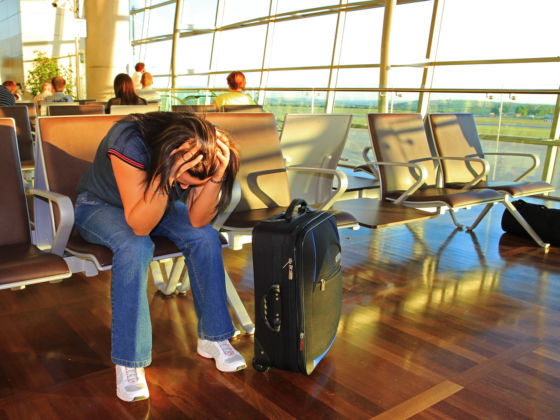Airports around the world suffer from design flaws so glaringly problematic you’d think they were created for some patience-testing prank show. Long distances between terminals, confusing layouts, and overcrowding due to poor planning are common complaints when it comes to the most frustrating airports in the world. To add insult to injury, some of the busiest international hubs are the worst offenders, particularly in the US. Do your best to avoid these seven airports if the run-of-the-mill stresses of air travel are all you can handle.

The 7 Most Frustrating Airports Around the World
1. Paris Charles de Gaulle Airport (CDG), Paris, France
Whoever designed CDG must have thought clear signage was meant to be decorative and decided to go in a different direction. It’s easy enough to get between the ticketing area and boarding gates, but connecting passengers have to pay attention and hustle if they intend to get through the airport in a timely manner. Terminals not only house narrow corridors that make pulling a wheelie suitcase or a pushing a cart impossible, but they’re also connected by unreliable shuttles and split into confusing subdivisions, so you never quite know where you’re going or how long it will take to get there. Expect to get lost or held up while traveling through CDG and budget for some extra time before your flight.
2. LaGuardia Airport (LGA), NYC, US
It’s no secret: LGA sucks. There’s no direct subway connection from NYC, so you’re doomed to start your trip by sitting in traffic and stressing out about missing your flight. The traffic problem isn’t limited to just cars, however; LGA also regularly experience air-traffic jams. Due in part to the close proximity of the JFK and Newark airports, this congestion often results in annoyingly long taxiing times. That said, the pre-boarding experience isn’t much better, especially if you have to deal with the run-around of getting between terminals after you’ve already cleared security. LGA is pretty underwhelming down to its last overlooked detail, like the simple fact that there are too few restrooms in Terminals A and B.
3. Ninoy Aquino International Airport (NAIA), Manila, Philippines
The largest airport in the Philippines, NAIA is a known nightmare. Millions of people pass through the Manila airport each year, which seems like way more than it was built to accommodate. The airport is always overcrowded, meaning excessively long lines for security and immigration, not to mention stiff competition for the limited seating at the boarding gates. Amenities, in general, weren’t high up on this designer’s list of priorities; food options and shopping outlets are practically nonexistent past security. Mostly what you’ll see at NAIA are people queuing up and waiting around while wearing exasperated expressions.
4. Frankfurt Airport (FRA), Frankfurt, Germany
FRA seriously challenges the cliche about German efficiency. Put simply, it makes no sense. The airport is connected by a maze of escalators, elevators, staircases, and tunnels that lead passengers through a seemingly random series of detours past ticketing, security, customs, passport control, and boarding. FRA is massive, so getting to your gate or terminal can feel like a hike. Then, even with all that extra space, there’s a good chance you’ll have to walk directly through a shop or restaurant to get to your gate. Unfortunately, the airport’s size is a burden for both departing and arriving passengers. Often, planes land a decent distance from the physical airport structure, and shuttle transfers to the terminals can take as long as 30 minutes.
5. São Paulo-Congonhas Airport (CGH), São Paulo, Brazil
CGH isn’t just frustrating; it’s downright dangerous. The runway is notoriously problematic, both because it’s shorter than a standard runway and because it suffers from drainage issues when it rains. Slippery runways have caused serious accidents in the past, and the airport has been shut down due to inclement weather before. While these design flaws are most problematic for pilots, CGH is also guilty of making transit hard on its passengers. Like others on this list, the airport is too small for its high number of travelers, which leads to never-ending queues that bleed together and become incredibly confusing on top of plain tedious.
6. Los Angeles International Airport (LAX), Los Angeles, US
LAX could be the official sponsor of Craigslist’s Missed Connections. The airport’s sprawling design is so easy to get tangled up in it has cost countless travelers their connecting flights over the years. Clearing customs, re-checking bags, and getting past TSA while navigating the crowds at LAX can take hours. There’s always a ton of foot traffic, and very often the line at security is so long it spills out into the ticketing area and delays passengers mid check-in. In truth, the whole entrance is a mess given that the infamously bad LA traffic doesn’t let up at the airport. LAX intends to add new gates to the Tom Bradley Terminal by 2019 but has announced no plans for the total redesign it so desperately needs.
7. Heathrow Airport (LHR), London, UK
There’s no time to dawdle at Heathrow, one of the largest and busiest airports in the world. The sheer volume of travelers can be overwhelming, especially when it comes to the long, snaking customs and immigration lines that make the airport feel at once too large and claustrophobic. There aren’t a lot of windows or natural light at Heathrow either, which adds to the cramped and overcrowded atmosphere. Another small but significant detail that qualifies LHR as one of the most frustrating airports on the planet is its ineffective signage. There’s so much going on between the shops, restaurants, and entertainment outlets that have been crammed into the airport that signs directing passengers to the boarding gates simply get lost. Sometimes LHR feels more like a mall than an airport, albeit still not one where you’d choose to spend the day.